Physical Address
304 North Cardinal St.
Dorchester Center, MA 02124
Treatment of cancer requires a multimodality approach, with most patients receiving chemotherapy, radiation, surgery, or a combination. It is important to understand the sequelae, complications, and imaging findings of each of the therapies to guide management of the oncologic patient. Preexisting conditions can also predispose a patient to such complications.
The efficacy of chemotherapy has allowed many patients with previously unresectable disease to proceed to surgical resection. However, chemotherapeutic agents used in treatment do have adverse effects. Chemotherapeutic side effects can occur at any time during the course of therapy. Late effects are increasingly being recognized. The field of immunotherapy has advanced cancer care. Along with the increasing use of immune-related agents, there is also increasing knowledge of immunotherapy-related adverse events (irAEs).
Radiation complications occur in an acute (<30 days) or chronic (>90 days) timeframe. The effects of radiation depend on the duration and dose of radiation therapy. Each organ has a specific dose tolerance that, when exceeded, can lead to injury. The combination of radiation and chemotherapy may also increase the extent of injury.
Surgical changes lead to possible infection and inflammation, and eventually, fibrosis. Knowing the normal postoperative appearance can be helpful in excluding recurrent disease.
Cross-sectional imaging (computed tomography [CT], magnetic resonance imaging [MRI]) and now positron emission tomography (PET)/CT are valuable tools in the management of the oncologic patient.
Hepatic steatosis is seen with administration of all chemotherapy agents, especially irinotecan and oxaliplatin. It can be focal or diffuse; when diffuse, it is called chemotherapy-associated steatohepatitis. Knowing the different imaging appearances and characteristic sites can aid in differentiating between liver metastases and fatty infiltration. Clues that a focal lesion may represent fatty infiltration are localization to the falciform ligament, porta hepatis, or gallbladder fossa and a geometric, well-defined shape. Ultrasound findings include increase in echogenicity. On CT, there is decreased attenuation of the liver ( Fig. 41.1 ). MRI with in- and out-of-phase imaging is very useful in confirming the diagnosis.
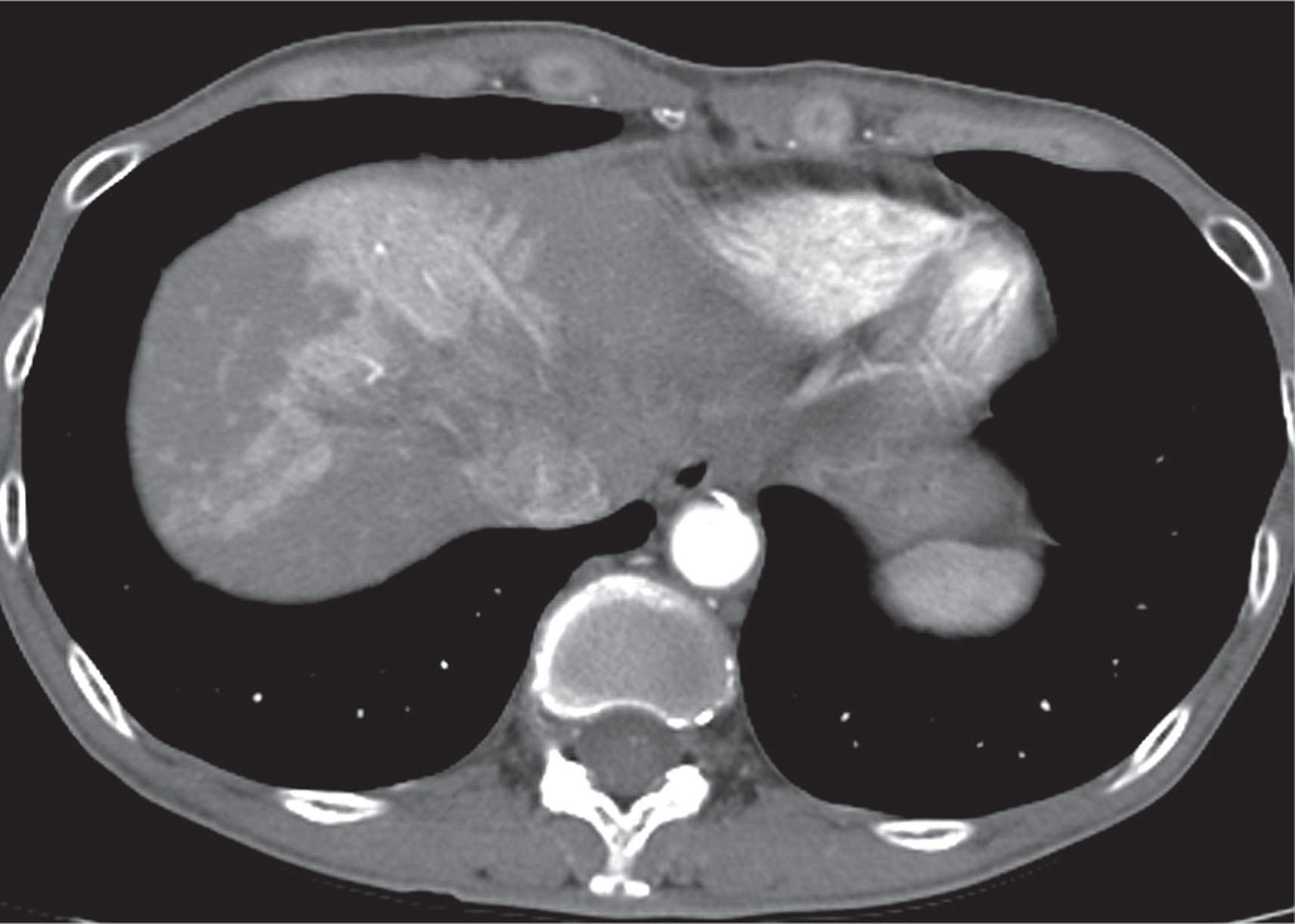
Hepatitis is associated with immune checkpoint inhibitors, such as with anti–cytotoxic T-lymphocyte–associated protein-4 (CTLA-4) agents such as ipilimumab and the tyrosine kinase inhibitors. Imaging findings include hypoattenuating lesions, periportal edema, and enhancing parenchyma on CT and 2-[ 18 F] fluoro-2-deoxy-D-glucose (FDG) uptake on PET/CT. The timing of the onset of hepatitis tends to differ depending on the agent used. Treatment includes steroids.
Portal vein thrombosis has also been seen with patients undergoing preoperative chemotherapy. Portal vein thrombosis is seen on CT as a filling defect within the portal vein. On ultrasound, there is echogenic thrombus within the portal vein. Branch portal vein thromboses can cause wedge-shaped areas of perfusion change, which need to be distinguished from development of metastatic disease ( Fig. 41.2 ). Treatment is conservative and consists of anticoagulation.
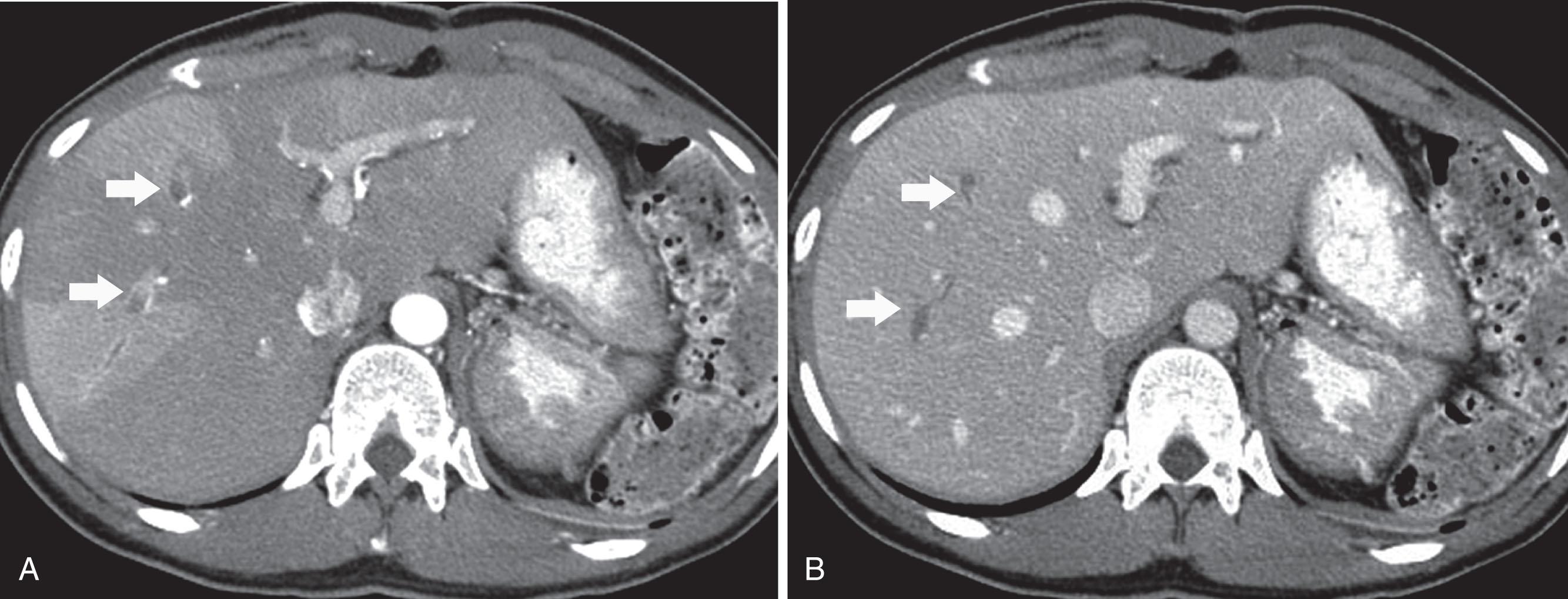
The effect of chemotherapy on small vessels can lead to peliosis, sclerosing cholangitis, and sinusoidal obstruction syndrome. Sinusoidal obstruction syndrome has been described after stem cell transplantation and also after treatment for colorectal liver metastatic disease with oxaliplatin. Clinically, the patients have hepatic failure and jaundice. CT findings include heterogeneous appearance of liver with narrowing of the right hepatic vein, periportal edema, and ascites ( Fig. 41.3 ). Ultrasound examination shows ascites; reversal of hepatic venous flow is a late sign. This can be distinguished from hepatic graft-versus-host disease (GVHD) by its early presentation in the first 20 days after stem cell transplant.
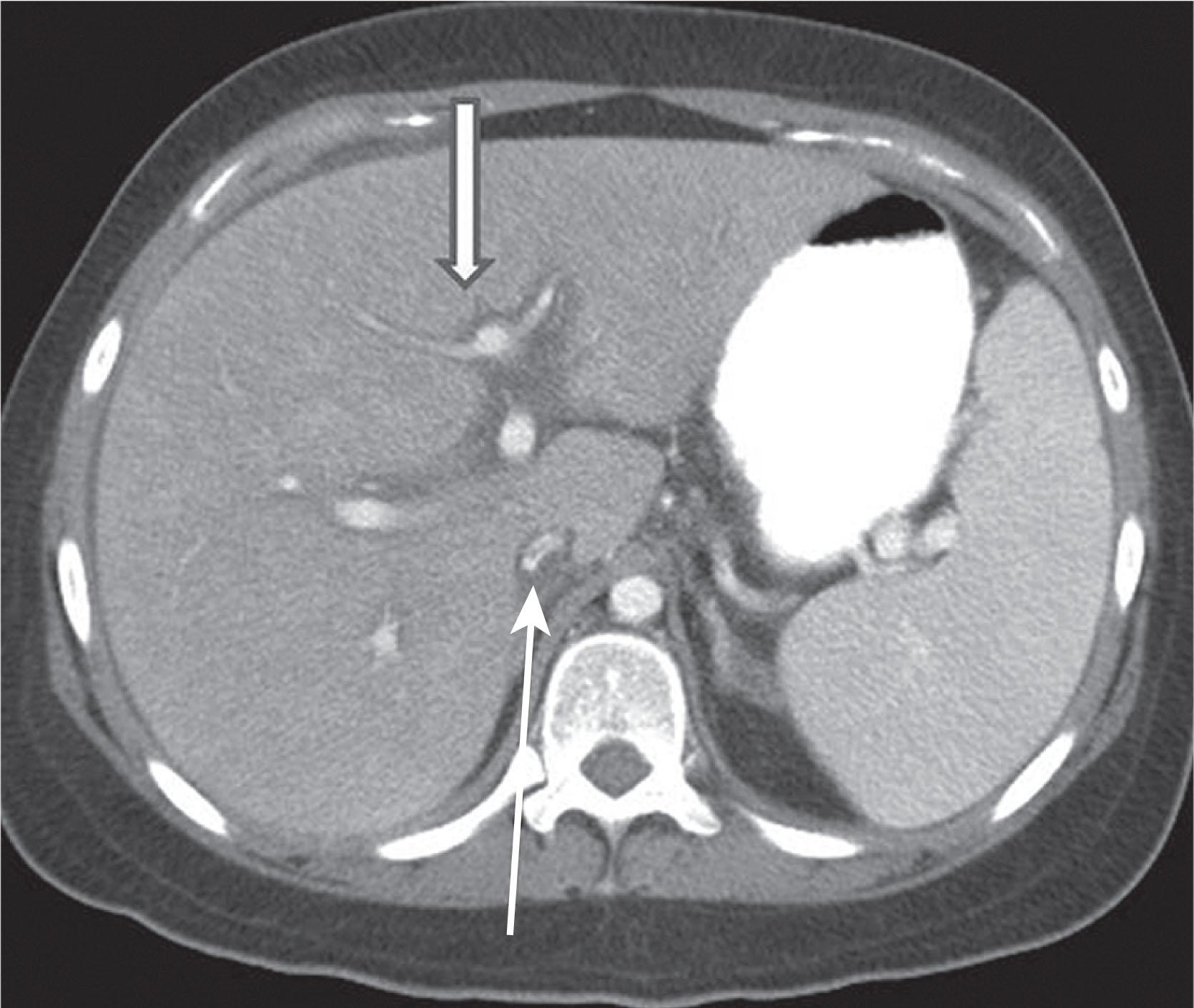
Pseudocirrhosis, or regenerative nodular hyperplasia, can occur after treatment with chemotherapy and is associated with drugs such as oxaliplatin, trastuzumab, paclitaxel, doxorubicin, and capecitabine. There is regenerating liver parenchyma without bridging fibrosis. This is in contrast to the form of pseudocirrhosis induced by an infiltrating tumor that causes fibrosis and occurs before the administration of chemotherapy. On CT, there is nodularity of the liver contour, caudate lobe enlargement, and a decrease in liver volume. Portal hypertension may occur.
Changes that have been observed after intraarterial chemotherapy infusion are chemical hepatitis, gastrointestinal ulceration, sclerosing cholangitis, and biliary cirrhosis.
Radiation-induced liver disease occurs in approximately 5% to 10% of people who received whole-liver irradiation in doses exceeding 30 to 35 Gy. Patients usually present 2 to 8 weeks (up to 4 months) after radiation exposure with hepatomegaly, ascites, and elevated liver enzymes. Pathologically, there is venoocclusive disease with congestion of the central portion of the lobule, with sparing of the larger veins. The radiologic picture is a clear demarcation—also known as the straight border sign—between the area that has received radiation and that which has not been irradiated. This can be differentiated from vascular changes, focal fat infiltration, and fibrosis by its nonanatomic distribution. In the acute and subacute phases, the area that has been irradiated is seen on CT to be lower in attenuation than the adjacent liver, likely because of edema ( Fig. 41.4 ). On MRI, the irradiated area has low signal intensity on T1 weighted imaging and high signal intensity on T2 weighted imaging because of edema. Chronic changes can occur, with fibrosis and volume loss. Usually, patients have resolution of findings in 3 to 5 months, but a small portion progress to liver failure.
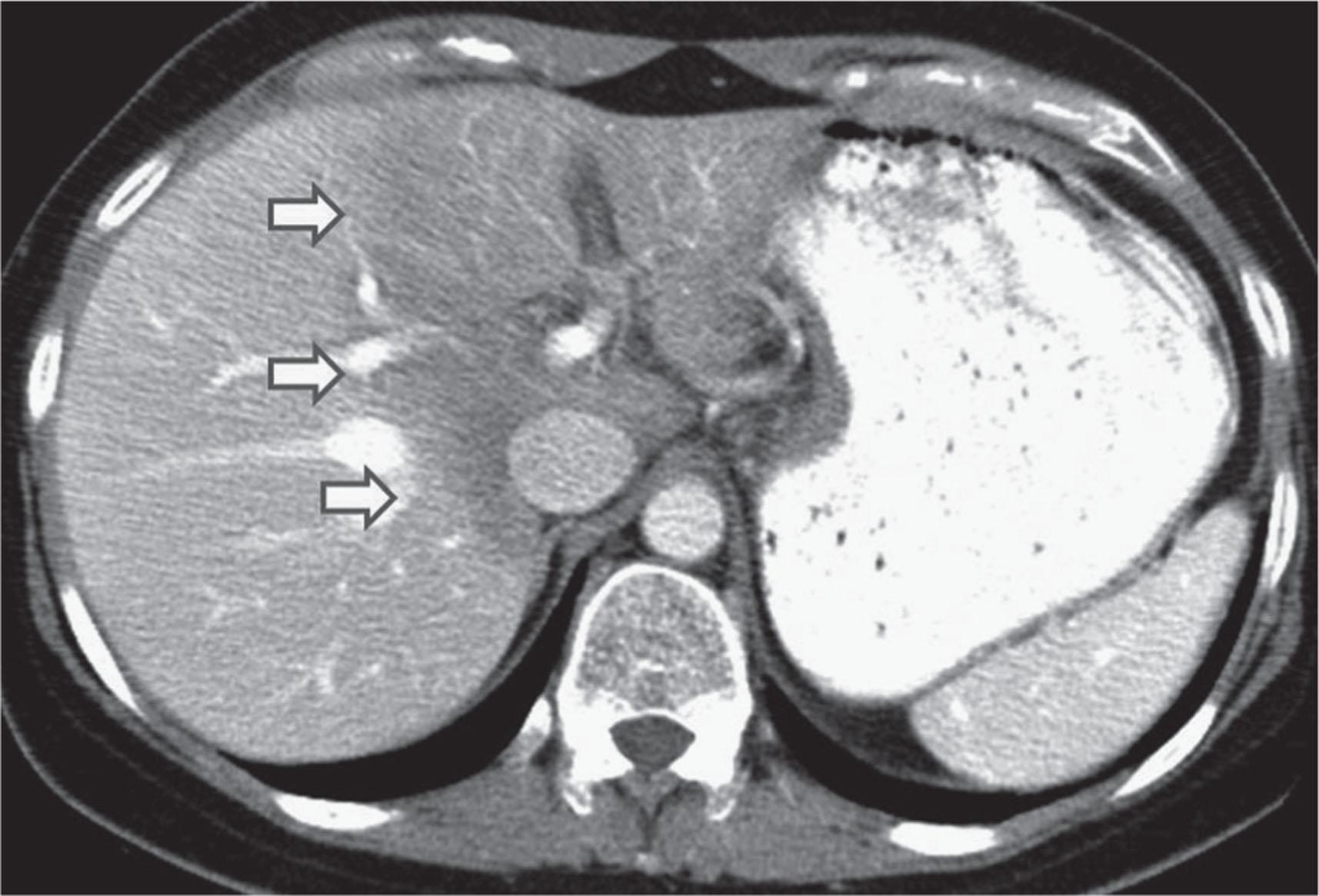
Postoperative fluid collections after hepatic resection are abscess, postoperative seromas, and bile duct leak. At our institution, these are usually drained percutaneously. Over time, these collections and the perfusion change along the hepatic surgical margin will resolve. It is important to distinguish between postsurgical change and recurrence of tumor by reviewing the initial imaging study in the postoperative period. Over time, the remaining liver may regenerate.
Image-guided thermal radiofrequency or microwave ablation is used in the treatment of metastatic disease to the liver. On CT and MRI, the ablation defect site is a low-density area in the place of the treated metastasis. There may be hypervascularity surrounding the surgical site initially, which usually resolves within 3 months. Both intrahepatic and extrahepatic complications can occur, depending on the location of the tumor intervention. Examples of complications include hemorrhage, vascular injury, biliary injury including bile leakage or biloma, gastrointestinal injury, cholecystitis, and, rarely, tumor seeding. It is important to distinguish these changes from recurrence, which is any change in the size of the cavity, mass effect, nodularity, and enhancement ( Fig. 41.5 ).
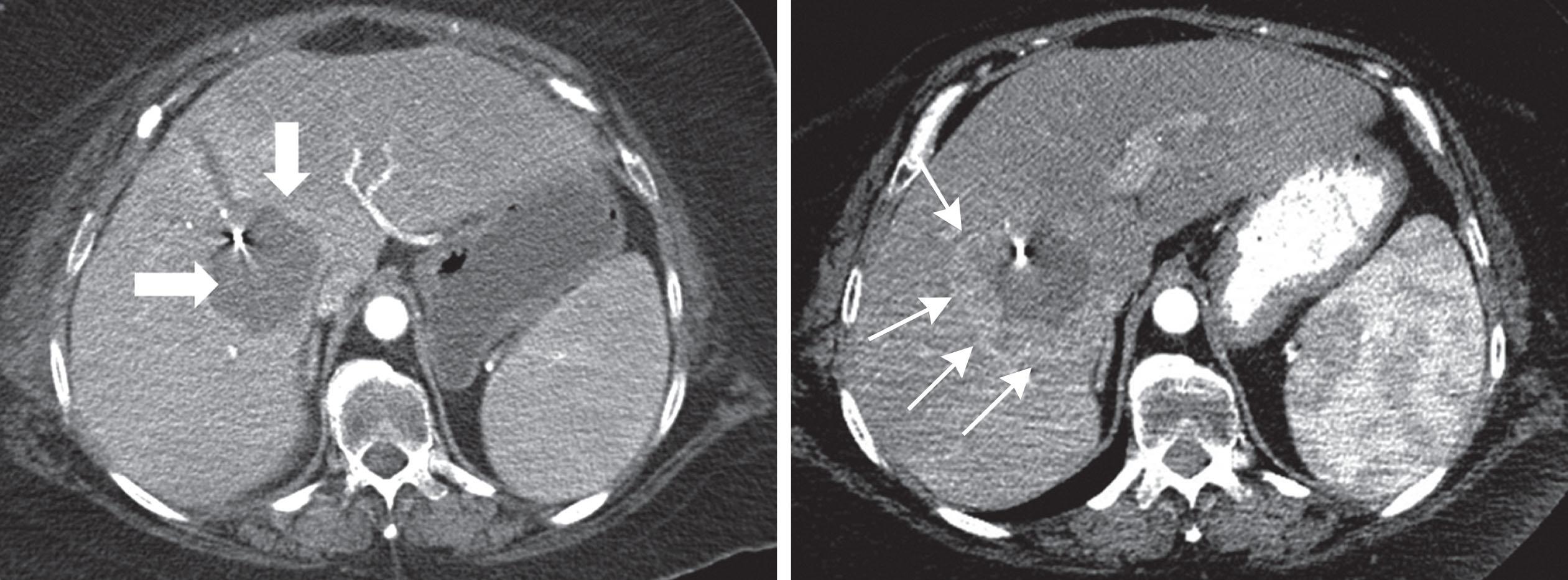
Cholecystitis is a complication of therapy resulting from the immunosuppression caused by conventional chemotherapy, immunotherapy, hepatic arterial infusion of chemotherapy, and hepatic arterial embolization. Patients may have classical symptoms of cholecystitis such as nausea, vomiting, or right upper quadrant pain. On imaging, the findings are much like the other causes of cholecystitis: pericholecystic fluid and thickening, gallbladder enlargement, and sonographic Murphy’s sign. One potential pitfall that may occur is pericholecystic fluid and thickening caused by therapy.
Certain chemotherapeutic agents, particularly oxaliplatin, can cause hepatic injury and portal hypertension, with resultant enlargement of the spleen and any adjacent splenules. This can be observed on routine screening CT with progressive enlargement of the spleen over the course of therapy. This finding has been seen to resolve within 2 years of cessation of therapy, which is suggestive of reversibility.
Splenic rupture is a rare complication of stem cell transplant or treatment with granulocyte–colony stimulating factor (G-CSF), which is administered for therapy-induced neutropenia. In splenic rupture, patients usually present with abdominal pain and left shoulder pain. On CT, there is irregularity of the spleen, splenomegaly, and high-density fluid surrounding the spleen and in the abdomen, consistent with hemoperitoneum. Treatment usually consists of intravenous hydration and resection of the spleen.
Radiation to the spleen is used for diseases such as lymphoma, hypersplenism, or splenomegaly. Radiation to adjacent organs can also impact the spleen. The spleen is very radiosensitive, and atrophy can result at small doses of approximately 4 to 8 Gy. Higher doses can result in fibrosis. Long-term effects that have been reported are functional asplenia and sepsis. Embolization of the spleen is now used more commonly. CT examination shows low-density areas with the spleen consistent with infarct. Eventually, the spleen will decrease in size.
Splenectomy is performed for lymphoma, myelodysplastic disease, or other hematologic malignancy to obtain total local control. If the spleen is also adjacent to tumors of the pancreas, retroperitoneum, peritoneum, or kidney, it may be removed as well. Occasionally, in the postsurgical bed, small splenules will develop or remain behind.
Chemotherapy-induced pancreatitis can occur during treatment. Many drugs can cause pancreatitis. Drug use history and timing of symptoms are critical in these patients. Pancreatitis can also occur as a complication in 2% to 7% of patients treated with hyperthermic intraperitoneal chemotherapy. Pancreatitis and elevated amylase can occur after transarterial chemoembolization or yttrium-90 therapy. Clinically, the patients present with abdominal pain and elevated amylase and lipase. The imaging appearance on CT, MRI, and ultrasound is similar to that of acute pancreatitis from other etiologies. Pancreatitis can be focal or diffuse. Both interstitial and necrotizing pancreatitis subtypes are seen on imaging.
Pancreatic atrophy has been seen in patients receiving sunitinib, and is associated with a poor prognosis.
Radiation injury to the pancreas can occur as a result of therapy directly or owing to irradiation for lymphoma or tumors of adjacent organs. Radiation treatment can also induce pancreatitis owing to damage of acinar cells. At the late stages, there may be fibrosis. Pancreatic atrophy as result of radiation may lead to endocrine insufficiency and diabetes.
Postoperative changes that are commonly seen at CT after pancreaticoduodenectomy are pneumobilia (particularly in the left lobe), normal jejunal loop, and postoperative fluid collections. CT is especially useful for the diagnosis of postoperative abscess, leaks, biloma, biliary obstruction, pancreatitis, and bowel obstruction.
Hepatic steatosis because of chemotherapy can be diffuse or focal. Knowledge of the typical location of fatty infiltration and magnetic resonance imaging or ultrasound can be helpful in confirming this diagnosis.
Radiation change of the liver has a characteristic appearance and should not be mistaken for recurrent tumor.
Enlargement of the spleen can be a result of chemotherapy-related sinusoidal obstruction syndrome, and patients who are receiving these agents should have follow-up of spleen size.
Recurrent pancreatic tumor can be distinguished from radiation change with biopsy.
Chemotherapeutic agents cause immunosuppression, which can lead to the bowel complications of Clostridium difficile infection, enterocolitis, and typhlitis. C. difficile infection and colitis can present with a spectrum of findings ranging from diarrhea to pseudomembranous colitis to fulminant colitis. Stool culture or endoscopy is used for diagnosis. CT scan findings include diffuse thickening of the bowel and mesenteric stranding. Treatment is antibiotic therapy.
Typhlitis or neutropenic colitis can be seen in children and adults being treated for hematologic malignancies or undergoing immunosuppressive therapies. On CT, typhlitis is seen most commonly as bowel wall thickening greater than 3 mm and inflammation of the terminal ileum and cecum, but can sometimes be seen in the entire bowel. Pneumatosis and fluid/abscess can also be seen. Ultrasound may be a useful imaging tool. Imaging is also helpful in determining extent and excluding other etiologies of pain. Treatment is supportive and consists of intravenous fluids, antibiotics, and, if necessary, G-CSF or surgery for bleeding.
Acute GVHD occurs within the first 100 days after transplant, and chronic GVHD occurs within 100 days after transplant. Acute GVHD clinically presents with cramping and diarrhea, which can be bloody. The diagnosis is usually made by endoscopy, but it can be seen on CT as bowel wall thickening ( Fig. 41.6 ). Chronic GVHD affects the small bowel and colon less commonly than acute GVHD. Patients can have malabsorption, sclerosis of the intestine, and fibrosis.
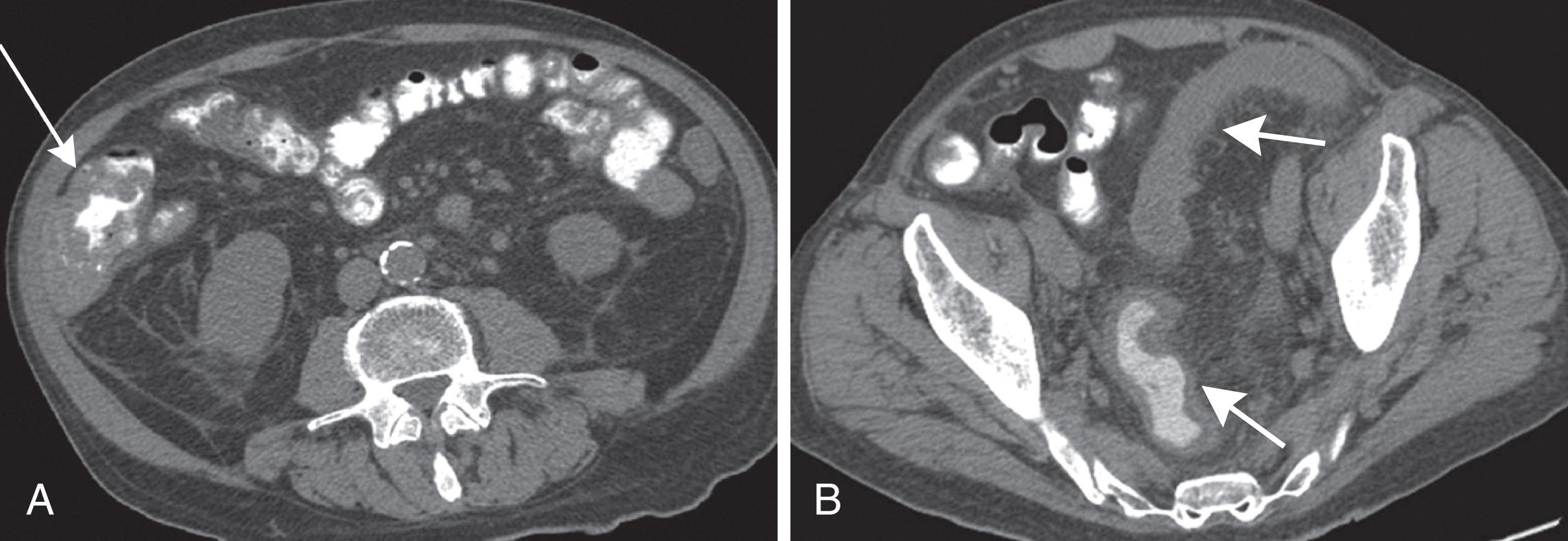
Immune checkpoint inhibitors are now more integrated into cancer care, such as bevacizumab for colorectal and ovarian cancers, ipilimumab for melanoma, and nivolumab for refractory lung and renal cell tumors. They affect the blood supply adjacent to the tumor and may have a system-wide thrombogenic effect. Perforation and fistulas, pneumatosis intestinalis, and enterocolitis are complications of treatment with the antivascular epithelial growth factor (VEGF) agent bevacizumab, anti–epidermal growth factor receptor agents, and the anti–CTLA-4 agent ipilimumab ( Fig. 41.7 ). The colitis seen with immunotherapy is associated with two patterns, with 75% of cases having a diffuse colitis pattern and approximately 25% of cases having a segmental colitis with diverticulosis pattern. Imaging features include mesenteric vessel engorgement, colonic wall thickening, and mucosal hyperenhancement.
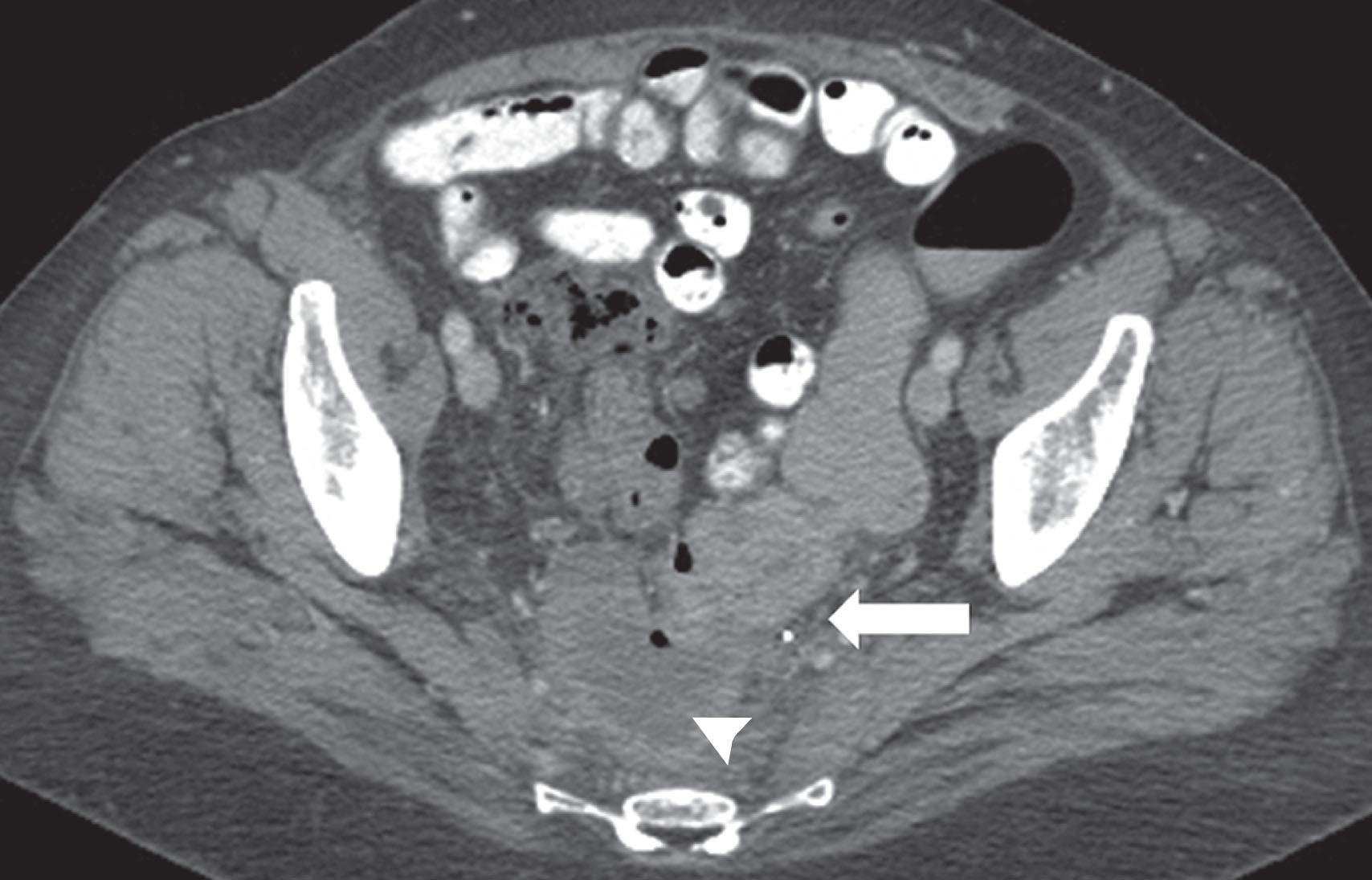
Become a Clinical Tree membership for Full access and enjoy Unlimited articles
If you are a member. Log in here